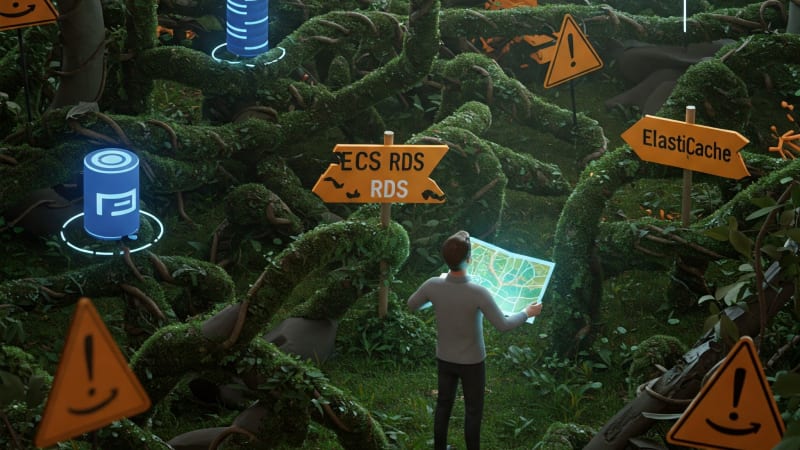
At first, Terraform feels effortless. A few lines of code, one apply, and AWS spins up: ECS services, SQS queues, RDS
clusters, and Redis nodes all humming. Everything just works. It’s magic—reproducible, predictable, empowering.
But as more components get added: new APIs, workers, queues, monitoring, the sprawl begins. What used to be a tidy template becomes a labyrinth. Infrastructure stretches across ECS, SQS, RDS, ElastiCache, IAM, networking layers, and more. All of it under Terraform’s watch, and all of it gradually harder to reason about.
The Terraform Honeymoon Phase
Terraform starts as a dream. Simplicity, clarity, and control. Teams feel empowered by clean, declarative code. Resources are self-documenting. Infrastructure feels like just another repo you can clone, review, and ship.
Changes are obvious. Plans are short. Anyone with terraform apply access can make informed changes. The world feels
contained. The infrastructure, though dynamic, feels like it’s in the palm of your hand.
But as environments multiply and stacks grow, elegance gives way to entropy. Outputs expand. Variables become harder to track. Abstractions blur. Terraform doesn’t scale its simplicity as quickly as your needs evolve. What was once a manageable stack becomes a brittle web.
The Stack That Outgrew Its Plan
Dozens of services and resources get stitched together: load-balanced APIs with path-based routing, queue-triggered workers handling long-lived jobs, relational and in-memory databases optimized for different use cases, alerting systems layered on top.
Infrastructure maps become complex networks of interdependent parts. A change in one module can ripple across four others. A single output might be referenced by a dozen different resources. Eventually, Terraform’s ability to clearly represent or safely change these dependencies starts to crack.
Challenge 1: Plan Diff Paralysis
Small changes surface massive diffs. A new tag? Suddenly dozens of resources are marked for update. A modified module input? Get ready for a wall of text.
Every plan turns into a scavenger hunt. What’s real? What’s a no-op? What’s an accidental replacement of a production resource?
Reviewing plan output becomes exhausting. Engineers scroll through hundreds of lines, trying to find needles in haystacks. The risk of unintentional change grows, and trust in automation declines. People start applying less frequently, not because they don’t want to, but because they’re afraid to.
Challenge 2: State File Weightlifting
Terraform’s .tfstate grows dense. It becomes an artifact to tiptoe around. Remote storage in S3 helps with sharing and
consistency, and DynamoDB locking adds safety - but neither solve the core issue.
The file holds everything. And that means even small missteps can affect the whole stack. One bad edit or failed run can throw state into disarray. Recovering means restoring backups, validating versions, or manually editing JSON, an act that should terrify any team.
Eventually, the team begins to treat it like glass—valuable but easily shattered. Work grinds to a halt while state is investigated. And nobody wants to be the one who broke it.
Challenge 3: Dependency Hell in Modules
Modules multiply and interlock. The web service module needs a queue from the async processor. The processor needs secrets from a shared data layer. Networking is centralized but referenced everywhere.
Each output becomes a potential choke point. Each input a potential misconfiguration. Over time, abstraction collapses under its own weight. Modules once meant to enforce boundaries now feel like traps - opaque, fragile, and hard to untangle.
Refactoring feels dangerous. Debugging is slow. Dependencies are undocumented and implicit. One small change can disrupt dozens of workflows, and you often don’t know until it’s too late.
Challenge 4: Environments Are Snowflakes
Dev, staging, and prod should match - but they don’t. Workspaces keep them separate in theory. But there’s no enforcement of parity. Nothing prevents ad hoc fixes or forgotten changes.
Over time, each environment drifts. One has an old version of a module. Another has a custom override. One has extra security groups added manually.
Debugging environment-specific bugs turns into a game of spot the difference. Teams waste hours trying to replicate a problem only to realize it exists in prod because of a tiny drift nobody noticed.
Challenge 5: Terraform Is Not a Workflow Tool
Terraform lacks guardrails. It doesn’t care how you apply changes - only that you do. There’s no built-in policy management. No approvals. No concept of roles or environment-specific checks.
Everything around the actual apply, how and when it’s done, relies on convention, CI pipelines, wrapper scripts, or tools. And even those have learning curves and limitations.
Without discipline, people start cutting corners. Changes skip review. Plans don’t get shared. Teams operate with unclear rules, and miscommunication leads to infrastructure drift - or worse, downtime.
What Helps (But Doesn’t Fix Everything)
Splitting the monolith helps. Breaking state down into focused domains like: networking, compute, and data, can reduce blast radius. Isolating modules and keeping their interfaces simple can make changes safer.
Linting with tflint, enforcing format with terraform fmt, and adding pre-commit hooks keep code consistent. CI
pipelines that post plan output to pull requests allow teams to review changes before merging. Drift detection through
scheduled plan-only runs helps surface issues early.
But none of these strategies solve the root challenge. They reduce risk, improve clarity, and create accountability, but they don’t stop Terraform from scaling beyond human comfort. The complexity returns. It always returns.
The Real Lesson
Infrastructure grows. Terraform reflects that growth but doesn’t tame it. It provides the building blocks, but not the blueprint for how to scale safely.
Teams that succeed with Terraform treat it not just as a tool, but as a system that demands discipline. They document relationships. They version modules. They build processes around reviews, testing, and safe deployments.
Because without that structure, Terraform turns into a house of cards. One unexpected change, and the whole system wobbles. The lesson is to build like someone else will maintain it in a thunderstorm and blindfolded. Because eventually, they will.